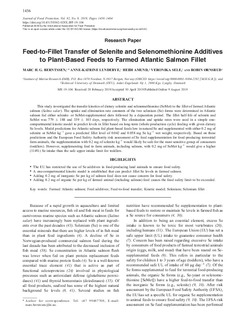| dc.contributor.author | Berntssen, Marc | |
| dc.contributor.author | Lundebye, Anne-Katrine | |
| dc.contributor.author | Amund, Heidi | |
| dc.contributor.author | Sele, Veronika | |
| dc.contributor.author | Ørnsrud, Robin | |
| dc.date.accessioned | 2020-01-13T12:26:26Z | |
| dc.date.available | 2020-01-13T12:26:26Z | |
| dc.date.created | 2020-01-06T12:25:36Z | |
| dc.date.issued | 2019 | |
| dc.identifier.citation | Journal of Food Protection. 2019, 82 (9), 1456-1464. | nb_NO |
| dc.identifier.issn | 0362-028X | |
| dc.identifier.uri | http://hdl.handle.net/11250/2635971 | |
| dc.description.abstract | This study investigated the transfer kinetics of dietary selenite and selenomethionine (SeMet) to the fillet of farmed Atlantic salmon (Salmo salar). The uptake and elimination rate constants of the two selenium (Se) forms were determined in Atlantic salmon fed either selenite- or SeMet-supplemented diets followed by a depuration period. The fillet half-life of selenite and SeMet was 779 ± 188 and 339 ± 103 days, respectively. The elimination and uptake rates were used in a simple one-compartmental kinetic model to predict levels in fillet based on long-term (whole production cycle) feeding with given dietary Se levels. Model predictions for Atlantic salmon fed plant-based feeds low in natural Se and supplemented with either 0.2 mg of selenite or SeMet kg−1 gave a predicted fillet level of 0.042 and 0.058 mg Se kg−1 wet weight, respectively. Based on these predictions and the European Food Safety Authority risk assessment of Se feed supplementation for food-producing terrestrial farm animals, the supplementation with 0.2 mg of selenite kg−1 would likely be safe for the most sensitive group of consumers (toddlers). However, supplementing feed to farm animals, including salmon, with 0.2 mg of SeMet kg−1 would give a higher (114%) Se intake than the safe upper intake limit for toddlers. | nb_NO |
| dc.language.iso | eng | nb_NO |
| dc.title | Feed-to-fillet transfer of selenite and selenomethionine additives to plant-based feeds to farmed atlantic salmon fillet | nb_NO |
| dc.type | Journal article | nb_NO |
| dc.type | Peer reviewed | nb_NO |
| dc.description.version | publishedVersion | nb_NO |
| dc.source.pagenumber | 1456-1464 | nb_NO |
| dc.source.volume | 82 | nb_NO |
| dc.source.journal | Journal of Food Protection | nb_NO |
| dc.source.issue | 9 | nb_NO |
| dc.identifier.doi | 10.4315/0362-028X.JFP-19-104 | |
| dc.identifier.cristin | 1766785 | |
| dc.relation.project | Fiskeri- og havbruksnæringens forskningsfinansiering: 900871 | nb_NO |
| cristin.unitcode | 7431,32,0,0 | |
| cristin.unitname | Trygt fôr | |
| cristin.ispublished | true | |
| cristin.fulltext | original | |
| cristin.qualitycode | 1 | |
